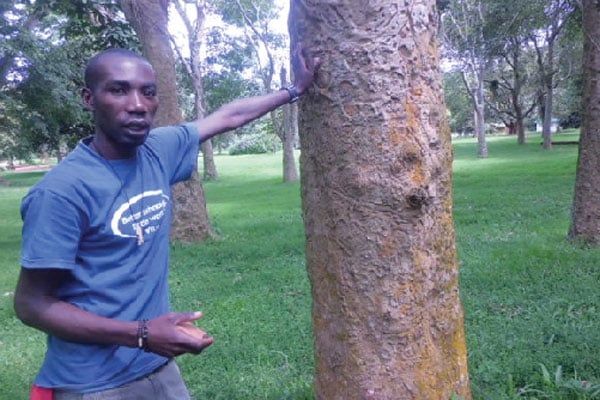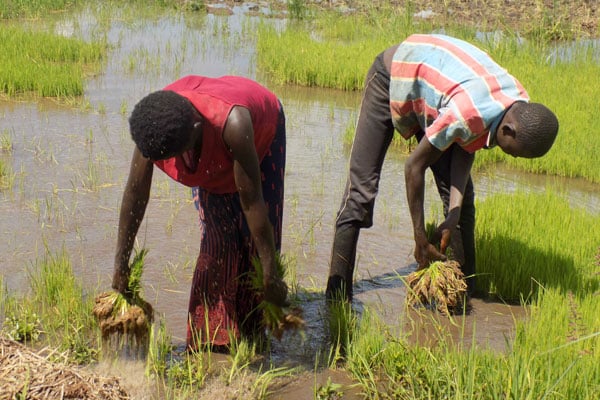Embracing rubber tree farming

An expert shows a rubber tree. Rubber is still lucrative despite competition from synthetic sources. PHOTO/LOMINDA AFEDRARU
What you need to know:
- Rubber farming can be profitable. 200 rubber trees can be planted in one acre land.
- Ten rubber sheets can be made from 200 trees a day. The farmers can harvest upto 150 kilogrammes rubber per month.
Farmers can tap into the earning potential of rubber. Native to the rainforests of the Amazon in South America, these trees are generally found in low-altitude, wetlands, riparian zones, forest gaps and areas which are not disturbed by human activity.
Like oil palm, it requires a high and year-round rainfall with little or no dry season and stable high temperatures where soils should not be particularly rich but must be deep and well drained.
Rubber is the major industrial product derived from the sap. Currently, natural rubber is rivalled by synthetic rubber, which is derived from oil products.
In Africa, rubber is mainly grown in Liberia, Nigeria and DR Congo, Mozambique, Madagascar.
In Uganda, the trees can be spotted at the Botanical Garden in Entebbe where the first explorers brought various species of plants for further testing. Other places where rubber trees can be found are Uganda Golf Course, Makerere University, Sheraton gardens and Constitutional Square.
According to available records Uganda businessman, Robert Giffen Kamulidwa, leased one square mile of a rubber plantation in Bujenje County, Masindi District, to produce smoked rubber sheets.
The owner of the abandoned rubber plantation wanted to turn it into sugarcane plantation but he persuaded her to lease it to his company Kibopi Estates so that he could continue the production of rubber on the land.
The company is reported to be selling its rubber products to Bata Shoe Company.
Agronomy
In a rubber tree production guide published in Dairy Business PH situated in Philippines, the publishers highlight various agronomic practices famers wishing should adopt the tree including selection of good disease-free varieties.
Rubber trees grow well in plain well-drained soils with deep water table with soil pH of 4.0-6.5
The way a farmer tills the land must enable good aeration containing abundant organic matter.
There has to be 80 per cent atmospheric humidity with moderate wind speed, average rainfall of 2000mm evenly distributed throughout the year, bright sunshine and there is no distinct dry and wet seasons.
Land preparation
Adequate clearing of the planting site is recommended to avoid competition for nutrients with weeds and second growth forest trees.
In flat cultivated areas, farmers are expected to plow the land twice before laying out.
In hilly areas, terracing is encouraged following the contour lines. And this must be done to prevent soil erosion.
Plant spacing largely depend on the topography of the area and the possibility of planting intercrops is possible with crops such as coffee or green vegetables.
Management
Pruning must be done regularly to develop a smooth trunk without branches or large scars on the stem along the optimum height of 2.5-3 meters from the ground. Pruning of the top portion of the tree is not a recommended practice.
The first three years of plantation establishment is the most critical period where complete nutrition should be provided to the plant. Ideally, fertiliser application should be based on the results of soil and plant tissue analysis to ensure that the optimum amount is applied.
Whole, broadcast and ring methods of fertiliser application can be used and application is made at the start and before the end of the rainy season. Organic fertilisers can be used as recommended by experts.
Weeds in rubber farms can be controlled by line weeding, slashing, round/ring weeding, and the use of herbicides. Weeds must be controlled or minimised to prevent stunted growth of the trees and to prevent fires during the dry season.
There are about six foliar fungal diseases of rubber which include bird’s eyespot, powdery mildew, leafspot, leaf blight, anthracnose algal spot which attack both the tree leaves and stems in some cases. Nursery diseases consist of seedling blight and tip blight which can be controlled by applying recommended chemicals.
Harvest
Rubber trees are ready for tapping when the trunk circumference reaches 75cm from the stock- and when the scion union reaches 40-50cm in circumference.
Tapping should start on the sixth or seventh year after planting. Farmers are expected to cut the three trunk and make a scion form which the sap can drip to an attached container which must be collected and poured in a bigger collection container.
Processing into rubber is done by the manufacturing industries.




